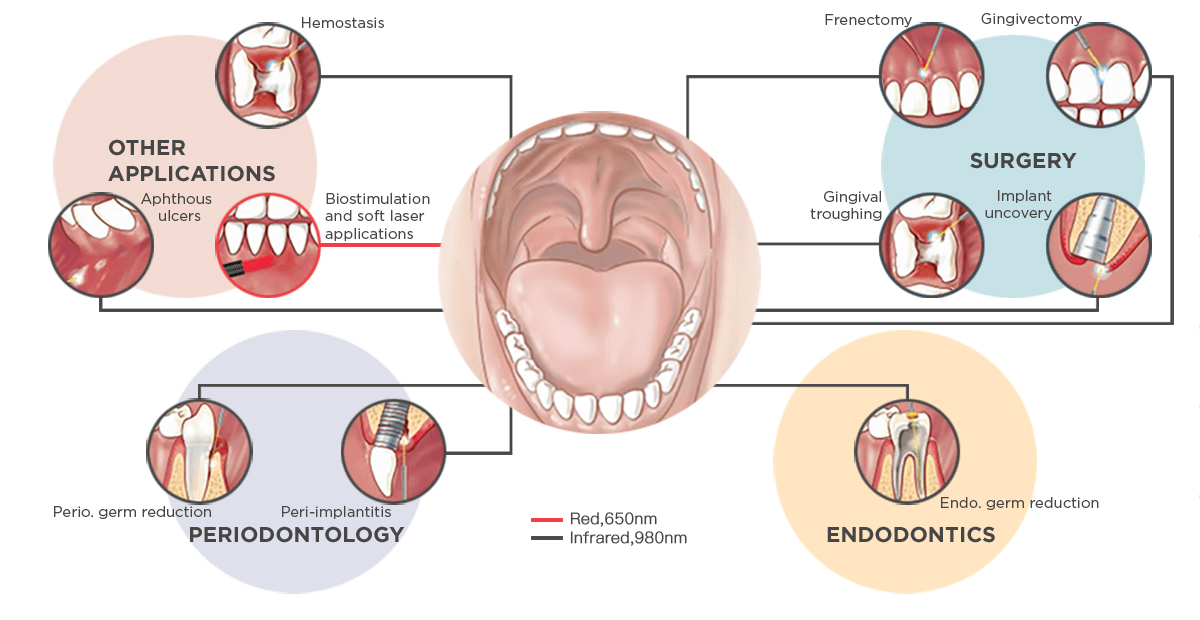
2022-08-09 1716
The National Journal of Maxillofacial Surgery says lasers have proven "to be an effective tool to increase efficiency, specificity, ease, and cost and comfort of the dental treatment." There are advantages of soft-tissue laser use in dentistry:
l Less risk and pain. There is a risk when anesthetics or anesthesia are administered.
l Reduced need for anesthetics and anesthesia.
l Increased precision and decreased recovery time. Using lasers gives the dentist more control and precision. The use of lasers is virtually pain-free and leaves the patient with less recovery.
l No more drills and scalpels. Lasers are less invasive, less noisy, less painful – and these characteristics can add up to less anxiety for patients.
Soft tissue laser dentistry is a pain-free dental procedure that can help with a variety of dental issues. Such as:
l Cavities
l Gingivitis
l Oral Surgery
l Cleaning and Whitening
...
1.Laser Use for Dental Cleaning
The use of soft tissue lasers for cleaning teeth is becoming more popular. The laser can efficiently and effectively rid the teeth of plaque and other foreign materials.
Cleaning the teeth in this fashion also kills bacteria and germs residing on the teeth and at the gum line. Cavities can be detected early using lasers by revealing even small amounts of tooth decay.
2.Lasers for Healing Tooth Sensitivity
Dental laser treatments also treat tooth sensitivity by sealing tubules, small canals, at the tooth root. These tubes are often exposed due to enamel loss.
This sensitivity to hot and cold can affect how a person consumes food and drink. It can also affect the person's brushing habits as their teeth may be sensitive to the toothpaste or water. Sensitivity issues can become a vicious cycle if not dealt with due to cavities developing from lack of brushing.
3.Laser Dentistry for Cavities
Having a cavity drilled with an electric drill is traumatic for patients. The sound and smell are enough to make people suffer from pain. Luckily, it no longer has to be a frightening experience.
The laser can precisely clear away the decay of the tooth. This leaves more of the healthy tooth intact.Using a laser dental procedure to fill the cavity is less invasive than using conventional drills. There is no noise or vibration, no needles, and your mouth will not be numb from Novocain injections.
4.Crown Lengthening With Oral Lasers
The diode laser is used to cut back the gum and expose the tooth underneath.
When someone has a severe cavity or a broken tooth that is below the gum line, the dentist or orthodontist needs to get below the surface of the gum and rebuild the bone and tooth. This is why the dentist may need to perform a crown lengthening.
Again, the use of the laser is less invasive in this procedure. It precisely removes the soft tissue around the affected tooth or teeth. Using the laser is less painful than a scalpel, and there is little to no blood during the session. Once the tissue has been removed from the base of the tooth, it can be rebuilt.
5.Lasers Used to Fight and Cure Gingivitis
Gingivitis is the dreaded gum disease, so many people have. It is caused by bad bacteria below the gum line. The symptoms of periodontal disease are difficult to ignore.
Halitosis (bad breath)
Red swollen gums
Bleeding gums
Bone loss of the jaw
Tooth sensitivity
Painful chewing
Tooth loss.
With soft tissue lasers, the procedure is not invasive as traditional treatment. There is less pain and swelling. The lasers target and kill the bacteria that are causing bone loss and tooth decay. It often helps save any healthy teeth you still have.
6.Laser Dentistry for Tooth Extractions
Whether it is a cavity that is beyond filling or wisdom tooth removal, lasers are used to help with tooth extractions. A laser can be used to cut through soft gum tissue.
While doing so, the laser immediately cauterizes the wound. To cauterize means to burn the skin around the wound to stop or prevent bleeding. This eliminates swelling and infection associated with open wounds in the mouth.
Dental lasers are also beginning to be used to help remove tooth roots very accurately. This causes less trauma to the surrounding bone and tissue.
7.Soft Tissue Lasers Used to Remove Ulcers
Canker sores are a type of ulcer called an aphthous ulcer. For some individuals, they are an ongoing problem and make eating and drinking painful and difficult. Using low light laser therapy, those with aphthous ulcers can be removed easily and without much pain.